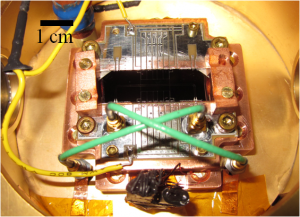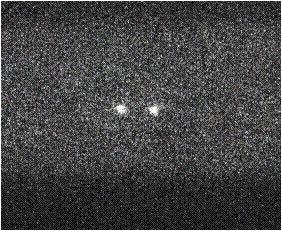Microwave Spectroscopy using Microfabricated Superconducting Ion Traps
- Category: Electronic Devices, Optics & Photonics
- Tags: david meyer, karl berggren
In recent years, several ion-trapping groups have shown that microwave electrodes integrated into surface electrode ion traps can be used for state manipulation of trapped ions [1] . Our group has pursued integrating microwave electrodes into superconducting ion traps to perform microwave spectroscopy in both atomic and molecular ions. Large fields are required to perform state manipulation, and these fields can be locally amplified using resonators. This amplification comes at the expense of bandwidth on the spectroscopic signal.
We designed microwave-integrated ion traps and fabricated them with a niobium on A-plane sapphire process in the Nanostructures Laboratory at MIT. We deposited thin films between 50-200 nm of niobium on the sapphire with an in-house DC magnetron sputtering system. Once we completed the material stack, we patterned the front niobium layer in PR1-2000A resist using the Heidelberg uPG-101 pattern generator, developed it, and then reactive-ion etched it with CF4 and O2 to transfer the pattern into the niobium
We are currently testing to see if our integrated microwave signals can excite the microwave clock transition in 87Sr+ ions. This experiment uses microwave signals to couple between two hyperfine levels in the ground state of 87Sr+. A laser excites the atom from one of the ground states to an excited state; when the atom decays back to one of the ground states, photons are emitted, and they can be imaged. Without the applied microwaves, the ion would quickly shelve into a dark state.
- Figure 1: Ion trap with mounting hardware inside experimental chamber within the vibrationally isolated cryostat.
- Figure 2: Trapped 87Sr+ ions in a crystal. This crystal also contains 88Sr+ ions inside, but they are dark due to the frequencies of the lasers.
- Ospelkaus, C., Warring, U., Colombe, Y., Brown, K.R., Amini, J.M., Leibfried, D., Wineland, D.J., “Microwave quantum logic gates for trapped ions,” Nature, vol. 476, no. 7359, pp. 181-184, 2011. [↩]

